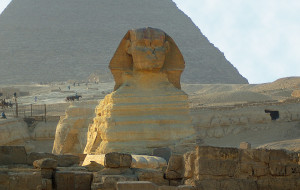
Great Sphinx and Pyramid of Khafra (Photo by Don Knebel)
The Great Sphinx, having the head of a man and the body of a lion, is the world’s largest monolithic statue. Carved in the limestone in the quarry from which the stones of the Great Pyramids were mined, the body is 241 feet long and the top of the head is 66 feet above the floor. For thousands of years, the body was covered with desert sand, creating the image of a disembodied head sometimes mistaken for an Egyptian goddess.
Despite its size, no Egyptian records mention the Great Sphinx and archaeologists are not sure when or why it was created. One popular theory is that the Sphinx honors Pharaoh Khafra, who ruled Egypt in about 2500 B.C. and whose pyramid, the second largest in Egypt, is nearby. Supporters of this theory believe the once-painted head is that of Khafra. Others claim the Sphinx was sculpted before Khafra, who discovered it buried in the sand and ordered his pyramid built alongside it. In 1932, American physic Edgar Cayce reported a vision revealing the Great Sphinx was built in 10,000 B.C. by survivors from Atlantis. That same year Cayce predicted that we would learn in 1958 that the Great Pyramids were built by workers somehow able to float their enormous stones in the air.
A fifteenth century Arab historian reported that the nose of the Sphinx was pried off by a Sufi Muslim outraged that locals were praying to the Great Sphinx for a successful harvest. But Giza guides have long claimed that cannon balls fired by Napoleon’s soldiers shattered the nose. Sketches made before the birth of Napoleon show Sphinx without his nose. Case closed.
Comments are closed.